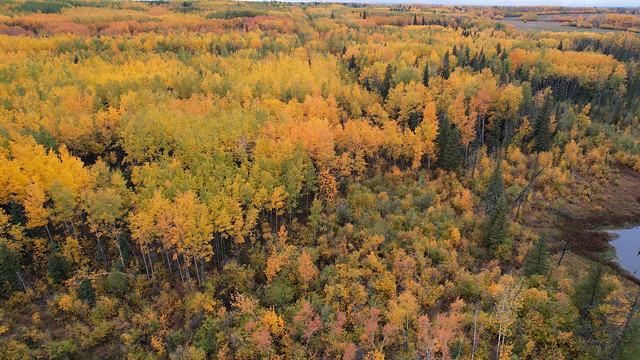
Industry News
News
Forestry Management
Harvesting
Alberta forest management plans will help combat wildfire risk: woodlands manager
November 30, 2023 By Emily Plihal, Local Journalism Initiative Reporter
 Aerial view of part of Forest Management Unit S19, near High Prairie. Photo source: Government of Alberta.
Aerial view of part of Forest Management Unit S19, near High Prairie. Photo source: Government of Alberta. The rampant fires that have burned across Canada in the last few years have left people wondering what can be done to prevent such devastation from happening again.
Mercer Peace River Pulp Ltd. woodlands manager Frazer Butt says that historical data shows forests in Alberta would burn every 35 to 100 years without suppression and prevention efforts.
“The forest industry understands that fires are an important part of the landscape and a natural part of the forest lifecycle, but large out of control wildfires endanger human lives, communities, and infrastructure,” he says.
“As part of the forest management planning process in Alberta, companies operating on public land must develop long-term forest management plans that forecast 200 years into the future,” he adds. “These plans are re-evaluated every 10 years and updated with new information. As part of these long-term plans, forestry companies use the latest technology to inventory and map areas of high wildfire threat, creating a wildfire threat assessment.”
Butt says the wildfire threat assessment is used to plan the next 10 years of harvest areas, targeting areas of extreme fire behaviour potential. He explains that older forest types are usually the targeted areas, largely because they’re starting to decay and fall over, adding to the potential fire fuel on the forest floor. By targeting the older forests, the companies are helping to reduce the possibility of an intense and quickly spread wildfire.
“Forest companies can also plan harvest areas to form a series of strategically harvested buffer zones,” he explains.
“This strategy can limit how fast fires can spread and can be very effective adjacent to communities as it slows the fire and allows more time for suppression efforts.”
As widely seen when driving through forested areas, companies also help reduce the risk of large wildfire through their salvage efforts.
Butt says as part of forest management plans, companies implement FireSmart planning into analysis and forecasting. He explains FireSmart plans to create a landscape where fires and associated impacts are reduced. He says this is accomplished by reduction of high to extreme fire behaviour potential within FireSmart community zones, reducing the exposure of communities and landscape values from wildfires, timber harvesting as a method of replicating natural fire disturbance and creating natural fire breaks, post-harvest species conversion as a method of maintaining moderate fire behaviour potential stands within community zones, and incorporating timber management and harvest sequencing into wildfire management plans and community wildfire mitigation strategies.
“Although forest companies do not mange specific wildlife species, we can however manage the habitat required by wildlife,” Butt says.
“With updated vegetation inventories, forest companies can model habitat over time, ensuring there is sufficient habitat for a variety of species. As part of the forest management planning process, habitat for certain species is specifically modelled over the 200-year planning horizon. These include species at risk, such as caribou, along with a variety of other key species that have specific habitat requirements, such as barred owl and a variety of songbirds.”
Butt says it’s vital to recognize the part climate change is playing in the increase of forest fires globally.
“Climate change has played a part in recent fires, less snow during the winter leads to drier spring conditions and the wildfire risk is therefore higher,” he says.
“As we experience increased temperatures and milder winters the risk of spring and summer wildfires will only increase. Forest management is the key to mitigating these risks, with strategies implemented during the forest management planning process, with operational practices developed to make an impact at the forest level.”
He adds climate change is playing a role in increased fires, but he says that a large percentage of wildfires are human caused. He notes that although forest management can mitigate some of the impacts of fire, he feels a greater emphasis should be placed on prevention.
“Forest management is key in the fight against the effects of climate change,” he says. “Climate change will likely alter the frequency and intensity of forest disturbances, including wildfires, blowdown events and insect outbreaks. Forest management plans, through long-term forecasting, can implement strategies to combat some of the potential impacts.”
Butt says to address the future conditions, such as projected drier climates, companies like Mercer are testing aspen seedlings from other regions in Alberta.
He adds as temperatures increase, they suspect trees from more southern regions will adapt better to the drier and warmer conditions in the north.
“The forest industry harvests less than a one per cent of Alberta’s forests each year and regenerates harvest areas to ensure we continue to have strong, biodiverse, healthy forests,” he says.
“Forest harvesting can create disturbance into the forest in a controlled and planned manner, very similar to how nature uses wildfire to ensure the health of the forest.”
Emily Plihal is a Local Journalism Initiative Reporter for South Peace News.
Print this page